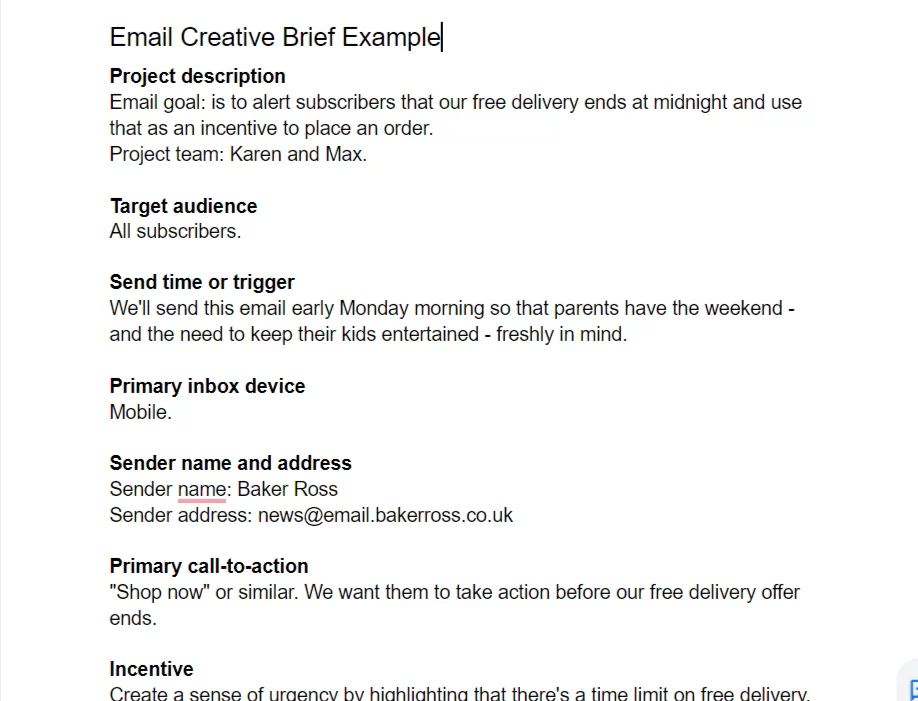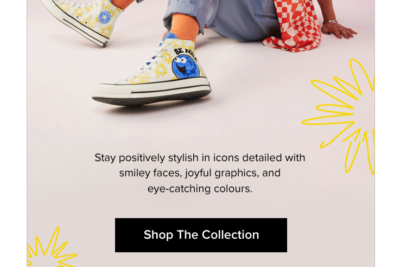There are a lot of steps to get from a new email idea to sending out that email.
With each step, there’s a chance that information gets lost or misinterpreted. That’s why it’s important to always have a structured email creative brief.
An email brief is a detailed and documented plan that makes it clear for everyone involved what the email is about, who it’s for, and what it should achieve. It ensures that all team members are on the same page about the goal of the email and prevents the concept of the new email from changing as it passes from copywriter to designer to developer.
Even if you’re working as a solo email marketer, creative email briefs are important. Because of the information they hold, they help ensure all of your emails support your overall marketing goals and serve a purpose.
An additional benefit of email briefs is that managing the email creation process becomes a breeze. If your creative brief contains all the necessary information, you should be able to answer every question about this new email with: “It’s in the creative brief”.
So, what should go into a good email brief?
11 Things to Include in an Email Creative Brief
1. A quick email description
Before you dive into the email’s details, give a two to three-sentence summary of what this email is about, who it’s for, what it should achieve, and whether it’s part of a larger marketing campaign or not.
This section is also a great place to list who will be working on the email.
2. Who the target audience is
Next, you want to outline who the target audience for this email is.
Is it all of your subscribers?
Only those who’ve bought from you in the last six months?
Is it a segment interested in a specific category of products?
When defining the audience for your email, make sure to use the same terms as the ones your team will find in your ESP. This avoids confusion about who exactly will be included in the emailing.
Link to any buyer persona documents you have that fit your target subscribers and add in any specifics for this campaign, like a certain pain point your email will address.
3. When the email will be sent and if it is part of a sequence
Do you want to reach your customers on the weekend or a weekday evening?
Depending on the action you want your subscribers to take, your sending time will be different and this, in turn, may affect the copy of your email. A clear example of this is an email to remind people to take advantage of a sale just a few hours before it ends.
Some emails won’t have specific send times but will, instead, go out based on a trigger. A good example of this are transactional emails such as purchase confirmation emails, which customers expect in their inbox as soon as they’ve placed an order.
Another thing to mention in your creative brief is whether an email is part of a larger drip campaign or not. If so, it needs to be created within the context of that sequence, taking into account the emails that come before and after it.
Lastly, include if the email is part of a larger marketing campaign that also comprises of paid advertising, influencer marketing, and billboard campaigns, for example. In this case, the email shouldn’t just follow the guidelines in the creative brief, it should also match the creative elements and key message of the overall campaign.
4. Where the email will be read
If you’ve been sending emails for a while, you should have data on whether your subscribers mostly open your emails on desktop or on mobile. Include that information in your creative brief so that your designer can adapt the layout for your email to the most-used device.
Also keep in mind that your sending time may influence which device your audience will read your email on. By emailing people outside of regular business hours, the chance of reaching them on their mobile phones increases quite a bit.
Aside from the device your subscribers are most likely to read their email on, it’s a good idea to also check which email client they’re using. Outlook for desktop, for example, doesn’t support GIFs, and so there’s no point using lots of GIFs when the majority of your subscribers are using this tool.
5. By whom the email will be sent
An email from “[email protected]” might be written in a less personal tone than one coming from “[email protected]” with Ben being the founder of the company. Sharing which email address and sender name an email will come from helps your creative team find the right format, tone of voice, and perspective.
We’ll go deeper into email design and copy guidelines further down this post. For now, we just want to urge you not to send any emails from a noreply email address. Here’s why.
6. Your CTA: What action should recipients take?
While one email can offer recipients several things to do, every email should have only one primary purpose and call-to-action that is highlighted by its design and copy.
In the email above, the primary goal of Baker Ross is clearly to get subscribers to take advantage of their free delivery before it ends. The free delivery is mentioned in the subject line of the email and in the massive image that takes up most of the email body. The “shop now” button to make use of this free delivery is also the biggest and most prominent CTA in the whole email.
There are other calls-to-action, such as the one asking subscribers to follow Baker Ross on social media and the links that go to various shop categories, but there’s no doubt about which action Baker Ross wants recipients of this email to take most.
On top of sharing the primary purpose of each email, you should make your creative team familiar with your products, social media activity, and customer service processes. These are the elements of your e-commerce business that will almost always get a place in your emails.
The better designers and copywriters know them, the better they’ll be able to present them to your subscribers.
While this familiarization process should be part of your overall internal communication strategy, you can always include some key points in your creative brief. A few examples of things that are worth emphasizing in your brief:
- benefits and features of a new product
- the presence of a loyalty program
- service benefits like free shipping
7. What the incentive for that action is
While super-fans may buy your latest product simply because they’re super-fans and will buy everything you launch, most recipients will need a little nudge to take action on your emails.
Whether you want to offer a discount, create urgency, or insert some social proof, that incentive should be described clearly in your email marketing brief.
8. How success will be tracked
While the people who create the email may not be the same people as those who track the results of your email marketing campaigns, they still need to know how those results will be tracked. This ensures that everyone’s on the same page about the goal of an email and understands which elements are most important.
Some key performance indicators you may track and want to mention in your creative brief are:
- open rate
- click-through rate
- generated sales
- social shares
- number of unsubscribes
9. Supporting material
Sometimes, the concept for a new email will come out of a brainstorming session. Other times, it may come from an article you’ve read, a case study a competitor published, or an industry report on email marketing. If the latter is the case, make sure to include this material in your creative brief to provide more context and help your team to get started.
10. Email design and copy
Who your email is for, when it will be sent, what its primary goal is… While all of the elements mentioned above will influence your email design and copy, you also need to include specific instructions in regards to style and structure.
Some things to include in your creative brief are:
- the color pallet to use
- the desired tone of voice
- the feeling you’re looking to create
- the email dimensions to keep in mind
- headers, footers, images, and other existing elements that should be used
Ideally, you already have a brand style guide that you can link to from your creative brief, and then you only need to add some specifics or mention where this email can deviate from those guidelines.
Even better than just explaining these things, is to include examples of what you’re looking for in your brief. With MailCharts, this becomes super easy. Our database allows you to search 1000s of email examples by type, industry, and brand. Sign up for a free trial and start exploring straight away.
11. A timeline
The final section of your creative brief includes a list of who needs to do what by when. It involves all the steps that go into the ideation, creation, reviewing, and sending of the email with specific deadlines for everyone involved.
Now that you know what needs to go into an email brief, let’s have a look at an email brief example.
Email Creative Brief Example

If we go back to the Baker Ross email we showed above, we can imagine the creative brief for that email could have looked a little like this:
Project description
The goal of this email is to alert subscribers that our free delivery ends at midnight and use that as an incentive to place an order.
Project team: Karen and Max
Target audience
All subscribers.
Send time or trigger
We’ll send this email early Monday morning so that parents have the weekend – and the need to keep their kids entertained – freshly in mind.
Primary inbox device
Mobile.
Sender name and address
Sender name: Baker Ross
Sender address: [email protected]
Primary call-to-action
“Shop now” or similar. We want them to take action before our free delivery offer ends.
Incentive
Create a sense of urgency by highlighting that there’s a time limit on free delivery.
Key performance indicators
Open and click-through rate.
Supporting material
Previous free shipping promotions we’ve sent out.
Email design and copy guidelines
Follow Baker Ross’ general brand guidelines.
Timeline
February 8: copy proposal ready
February 10: copy proposal reviewed and approved
February 11: email design proposal ready
February 15: email design reviewed and approved
February 17: final check of email in ESP
February 18: email scheduled to be sent on March 1
March 1: confirm email sending
Creative Briefs Are The Foundation of Successful Emails
A good creative email brief contains all the information needed to successfully execute an email concept. It makes sure everyone involved knows who the email is for, what goal it’s supposed to achieve, what it should look like, and how it fits into the company’s larger marketing goals throughout each step of the creation process. As such, it’s the crucial first component of each new email campaign.
Now that you know what to include in the brief for your next email campaign, get some inspiration by browsing campaigns by hundreds of other ecommerce brands. Sign up for a free trial and get started.





